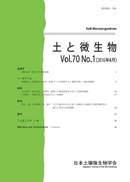Volume 32
Displaying 1-12 of 12 articles from this issue
- |<
- <
- 1
- >
- >|
-
Article type: Article
1988Volume 32 Pages 1-2
Published: October 01, 1988
Released on J-STAGE: May 31, 2017
Download PDF (226K) -
Article type: Article
1988Volume 32 Pages 3-13
Published: October 01, 1988
Released on J-STAGE: May 31, 2017
Download PDF (1077K) -
Article type: Article
1988Volume 32 Pages 15-23
Published: October 01, 1988
Released on J-STAGE: May 31, 2017
Download PDF (896K) -
Article type: Article
1988Volume 32 Pages 25-31
Published: October 01, 1988
Released on J-STAGE: May 31, 2017
Download PDF (533K) -
Article type: Article
1988Volume 32 Pages 33-39
Published: October 01, 1988
Released on J-STAGE: May 31, 2017
Download PDF (1061K) -
Article type: Article
1988Volume 32 Pages 41-48
Published: October 01, 1988
Released on J-STAGE: May 31, 2017
Download PDF (1114K) -
Article type: Article
1988Volume 32 Pages 49-
Published: October 01, 1988
Released on J-STAGE: May 31, 2017
Download PDF (152K) -
Article type: Article
1988Volume 32 Pages 49-50
Published: October 01, 1988
Released on J-STAGE: May 31, 2017
Download PDF (264K) -
Article type: Article
1988Volume 32 Pages 51-
Published: October 01, 1988
Released on J-STAGE: May 31, 2017
Download PDF (190K) -
Article type: Article
1988Volume 32 Pages 52-
Published: October 01, 1988
Released on J-STAGE: May 31, 2017
Download PDF (223K) -
Article type: Article
1988Volume 32 Pages 52-53
Published: October 01, 1988
Released on J-STAGE: May 31, 2017
Download PDF (355K) -
Article type: Article
1988Volume 32 Pages 53-54
Published: October 01, 1988
Released on J-STAGE: May 31, 2017
Download PDF (225K)
- |<
- <
- 1
- >
- >|
